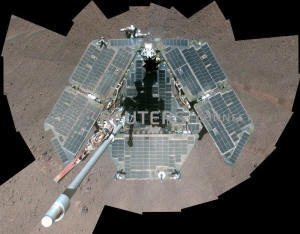|
NASA bids adieu to Opportunity, the Mars
rover that kept going and going
 Send a link to a friend
Send a link to a friend
 [February 14, 2019]
By Alex Dobuzinskis [February 14, 2019]
By Alex Dobuzinskis
LOS ANGELES (Reuters) - Opportunity, a
remarkably durable NASA rover designed to roll along the surface of Mars
for three months, has stopped communicating with Earth after 15 years of
service, officials said on Wednesday, ending a mission that astounded
the U.S. space agency.
Engineers lost contact with the solar-powered vehicle on June 10 during
a dust storm that encircled Mars. Since then, NASA officials made
numerous attempts to reach the six-wheeled rover, which is about the
size of a golf cart.
Opportunity's equipment may have been compromised by the storm, which
struck while the rover was at a site called Perseverance Valley and
blotted out sunlight needed by the robot's solar panels, officials said.
The vehicle was built to drive six-tenths of a mile (1 km), but ended up
covering 28 miles (45 km) and lasting longer on Mars than any other
robot sent to the surface of the Red Planet.

On Tuesday, engineers sent a transmission in a last attempt to revive
the rover, but heard nothing back, said Thomas Zurbuchen, associate
administrator for NASA's Science Mission Directorate.
"It is, therefore, that I am standing here with a sense of deep
appreciation and gratitude that I declare the Opportunity mission as
complete," Zurbuchen said during an online video presentation at the Jet
Propulsion Laboratory in Pasadena, California.
WET AND WARM MARS
As Opportunity explored craters on Mars, it gathered evidence to
demonstrate the planet in the ancient past was wet and warm enough to
possibly sustain life, NASA said. That included the discovery of white
veins of the mineral gypsum, an indication of water moving through
underground fractures.
Opportunity landed on Mars in January 2004, a few weeks after its rover
twin, Spirit.
[to top of second column]
|

A self-portrait of NASA's Mars Exploration Rover Opportunity, a
combination of multiple frames taken by Opportunity's panoramic
camera (Pancam) during March 22 through March 24, 2014 on planet
Mars is seen in this NASA/JPL-Caltech image released on April 17,
2014. Courtesy NASA/JPL-Caltech/Cornell University/Arizona State
University/Handout via REUTERS

Spirit ended its mission in 2010 after becoming stuck in soft soil.
The Opportunity mission cost more than $1 billion, with about 300
JPL staff members dedicated to the project soon after it landed,
John Callas, project manager for Mars Exploration Rovers, said by
phone.
The team had dwindled to 30 by the time Opportunity went silent, he
said. Its members are going to other projects.
Another NASA rover called Curiosity, which arrived on Mars in 2012,
continues its work on the Martian surface, collecting soil samples
to analyze them for signs of organic compounds.
And NASA's InSight spacecraft, the first robotic lander designed to
study the deep interior of a distant world, touched down safely on
the surface of Mars in November, with instruments to detect
planetary seismic rumblings never measured anywhere but Earth.
InSight and the next Mars rover mission, scheduled for 2020, are
both seen as precursors for eventual human exploration of Mars, an
objective NASA Administrator Jim Bridenstine has said might be
achieved as early as the mid-2030s.
(Reporting by Alex Dobuzinskis; Editing by Will Dunham, Bill Tarrant
and Rosalba O'Brien)
[© 2019 Thomson Reuters. All rights
reserved.]
Copyright 2019 Reuters. All rights reserved. This material may not be published,
broadcast, rewritten or redistributed.
Thompson Reuters is solely responsible for this content.
 |